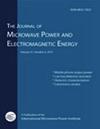土壤介电特性随土壤类别和含水量的函数的测量和建模
IF 0.9
4区 工程技术
Q4 ENGINEERING, CHEMICAL
Journal of Microwave Power and Electromagnetic Energy
Pub Date : 2020-01-02
DOI:10.1080/08327823.2020.1714103
引用次数: 20
摘要
摘要在700-7000 MHz微波频率范围内,采用带开放式同轴探针的矢量网络分析仪,在室温(25±2°C)条件下,研究了粘土、粘土壤土、壤土和壤土四种质地类型土壤的介电特性。保持土壤含水量4个水平(烘箱干燥、33%田间容量、66%田间容量和100%田间容量),进行3次重复和3次观察试验。结果表明,随着土壤含水量的增加,从烘箱干燥状态到100%的现场容量,介电特性的实(介电常数)和虚(损耗因子)分量均增加;然而,这些反应并不是线性的。与高含水率的土壤相比,烘干土的介电性能很低。因此,土壤水分是影响土壤介电特性的主要因素。砂质土的介电性能明显低于其他土;但杜基黏土的介电损耗系数高于其他土体。建立了模型来解释土壤的介电特性作为频率和含水量的函数。这些模型的拟合优度(r2)在杜基沙土的0.952和杜基壤土的0.997之间变化,表明这些模型足以描述这些土壤在本研究评估的频率和含水量范围内的介电特性。在介质特性模型的基础上,建立了另一个模型来估计电磁波在这些土壤中的预期穿透深度。很明显,渗透随频率和含水量的增加而减少。低频比高频深入土壤。同样,干燥的土壤比潮湿的土壤更容易渗透。本文章由计算机程序翻译,如有差异,请以英文原文为准。
Measurement and modelling of soil dielectric properties as a function of soil class and moisture content
Abstract In this study, four textural classes of soil (Clay, Clay Loam, Loam, and Loamy Sand) were used to investigate the dielectric properties of soils, using a vector network analyser with an open-ended coaxial probe kit at room temperature (25 ± 2°C) in the 700–7000 MHz microwave frequency range. Four levels of soil moisture content (oven dry, 33% field capacity, 66% field capacity and 100% field capacity) were maintained to perform the experiment with three replication and three observation each. The results showed that, with increasing soil moisture, from oven dry conditions to 100% field capacity, both the real (Dielectric Constant) and imaginary (Loss Factor) components of the dielectric properties increased; however, the responses were not linear. The dielectric properties of oven dry soils were very low compared with the soils with higher moisture content. Therefore, soil moisture was the major contributor to the dielectric behaviour of soil. The dielectric properties of sandy soil were much lower than the other soils; however, the dielectric loss factor of the Dookie clay soil was higher compare with the other soils. Models were developed to explain the dielectric properties of soils as a function of frequency and moisture content. The goodness of fit (r2) for these models varies between 0.952 for the Dookie Sandy Soil to 0.997 for the Dookie Loam Soil, suggesting that these models were adequate to describe the dielectric properties of these soils over the range of frequencies and moisture contents assessed in this study. Another model was developed to estimate the expected penetration depth of electromagnetic waves in these soils, based on the model of the dielectric properties. It was clear that penetration decreases with both frequency and moisture content. Low frequencies penetrate further into the soils than higher frequencies. Similarly, dry soils allow further penetration than moist soils.
求助全文
通过发布文献求助,成功后即可免费获取论文全文。
去求助
来源期刊

Journal of Microwave Power and Electromagnetic Energy
ENGINEERING, CHEMICAL-ENGINEERING, ELECTRICAL & ELECTRONIC
CiteScore
2.50
自引率
6.70%
发文量
21
期刊介绍:
The Journal of the Microwave Power Energy (JMPEE) is a quarterly publication of the International Microwave Power Institute (IMPI), aimed to be one of the primary sources of the most reliable information in the arts and sciences of microwave and RF technology. JMPEE provides space to engineers and researchers for presenting papers about non-communication applications of microwave and RF, mostly industrial, scientific, medical and instrumentation. Topics include, but are not limited to: applications in materials science and nanotechnology, characterization of biological tissues, food industry applications, green chemistry, health and therapeutic applications, microwave chemistry, microwave processing of materials, soil remediation, and waste processing.
 求助内容:
求助内容: 应助结果提醒方式:
应助结果提醒方式:


